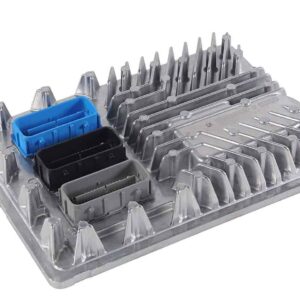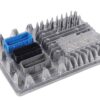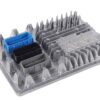Restore Your Truck’s Core Performance and Reliability
Is your 2018 Silverado 1500 acting up? Intermittent stalls, poor fuel mileage, or a persistent Check Engine Light can be incredibly frustrating. As a technician with over two decades of experience, I’ve seen firsthand how a failing Engine Control Module (ECM) can wreak havoc on a perfectly good vehicle. The ECM is the brain of your engine, managing everything from fuel injection to spark timing. When it fails, your truck’s performance and reliability suffer. This isn’t just an inconvenience; it’s a critical component failure that needs a solid fix.
This isn’t a generic, one-size-fits-all part. This is a direct-replacement Engine Control Module (interchangeable with part numbers 12704475, 12692069, 12680656, 12686383, and 12688528) that we program specifically to your truck’s Vehicle Identification Number (VIN) before it ships. This means it arrives loaded with the latest factory software from GM, tailored to your vehicle’s exact specifications. You get a precise, reliable solution without the expensive trip to the dealership for programming.
A Technician’s Notebook: The Intermittent No-Start
I remember a 2018 Sierra that came into the bay with a phantom no-start condition. The owner had replaced the battery and starter, but every few days, it would just crank with no fire. Scans were inconsistent. After checking all the power and ground circuits to the ECM, we noticed a tiny bit of corrosion on one of the main connector pins. On these trucks, the ECM is in the engine bay, exposed to heat and moisture. We swapped in a VIN-programmed module like this one, performed the security relearn, and the truck fired up every single time. It’s often the central component you least suspect.
Is Your Truck Showing These Symptoms?
A faulty engine computer can manifest in numerous ways. If you’re experiencing any of the following, a failing ECM could be the culprit. I’ve personally linked these symptoms to hundreds of ECM failures in my career, often accompanied by diagnostic trouble codes (DTCs) like P0601, P0606, or U0100 communication errors.
- ✔ Check Engine Light is on with no clear cause
- ✔ Engine cranks but refuses to start
- ✔ Noticeable drop in fuel economy
- ✔ Rough idling or stalling
- ✔ Hesitation or misfires during acceleration
- ✔ Transmission shifting issues or harsh shifts
- ✔ Communication errors with other vehicle modules
A Straightforward Guide to Your 2018 Silverado 1500 ECM Installation
Replacing the ECM is a manageable job for a DIYer with basic tools or a quick task for a professional mechanic. Following these steps ensures a smooth process.
- Safety First: Always disconnect the negative terminal from your vehicle’s battery before starting any electrical work.
- Locate the ECM: On the 2018 Silverado 1500, the ECM is typically found in the engine compartment on the driver’s side, near the firewall or inner fender.
- Disconnect Connectors: Carefully release the locking tabs on the electrical connectors and pull them straight out from the module. Avoid pulling on the wires themselves.
- Remove the Old Module: Unbolt the old ECM from its mounting bracket. Keep the hardware, as you may need it for the new installation.
- Install the New ECM: Mount your new, pre-programmed ECM onto the bracket and securely fasten it. Reconnect the electrical connectors, ensuring they click into place.
- Reconnect Battery: Reattach the negative battery terminal.
- Perform Relearn Procedures: This is a critical final step. The vehicle’s anti-theft system must be synchronized with the new ECM. This often requires a GM-specific scan tool (like Tis2web/Techline Connect). Other procedures, such as a crankshaft position variation relearn, may also be necessary for optimal performance. This is the responsibility of the installer.
Verified Vehicle Compatibility
This module is engineered to be a direct replacement for a wide range of GM vehicles. Please verify your specific model and options below. Providing your VIN at checkout is mandatory to ensure we send you a perfectly matched and programmed part.
- 2018-2019 Chevrolet Corvette (RH cowl under dash)
- 2018 Chevrolet Silverado 1500 Pickup (LH front engine compartment)
- 2018 GMC Sierra 1500 Pickup (LH front engine compartment)
- 2018 GMC Sierra Denali 1500 (LH front engine compartment)
- 2018 Chevrolet Suburban 1500 (LH front engine compartment)
- 2018 Chevrolet Tahoe (LH front engine compartment)
- 2018 Cadillac Escalade / Escalade ESV (Engine compartment)
- 2018 GMC Yukon / Yukon XL 1500 (LH front engine compartment)
- 2018 Chevrolet Express 2500/3500 Van (4.3L) (LH rear engine compartment)
- 2018 GMC Savana 2500/3500 Van (4.3L) (LH rear engine compartment)
- 2018 Cadillac XTS (3.6L)
Frequently Asked Questions
Why do you need my VIN?
Your Vehicle Identification Number (VIN) is essential. We use it to load the precise, vehicle-specific GM software and calibrations onto the ECM. This ensures perfect compatibility with your truck’s engine, transmission, and options, saving you a programming fee at a dealership.
What is a “theft relearn” and can I do it myself?
The theft relearn (or security relearn) synchronizes the new ECM with your vehicle’s anti-theft system. Without it, the vehicle will not start. While some older models had a manual procedure, most modern GM vehicles, including this one, require a professional scan tool with access to GM’s software (like Techline Connect) to complete the process. This is typically done by a repair shop.
Is this part difficult to install?
The physical installation is straightforward, involving simple hand tools to unbolt the old unit and mount the new one. The main challenge is the electronic relearn procedures required after installation. If you are not equipped to perform the security relearn, we recommend having a professional mechanic complete the installation.
Will this ECM fix my check engine light?
If the check engine light is caused by an internal failure of the original ECM (e.g., DTC P0601, P0606), then this replacement part is the correct solution. However, if the light is on due to other issues like a bad sensor or wiring problem, those issues must be diagnosed and repaired separately.



